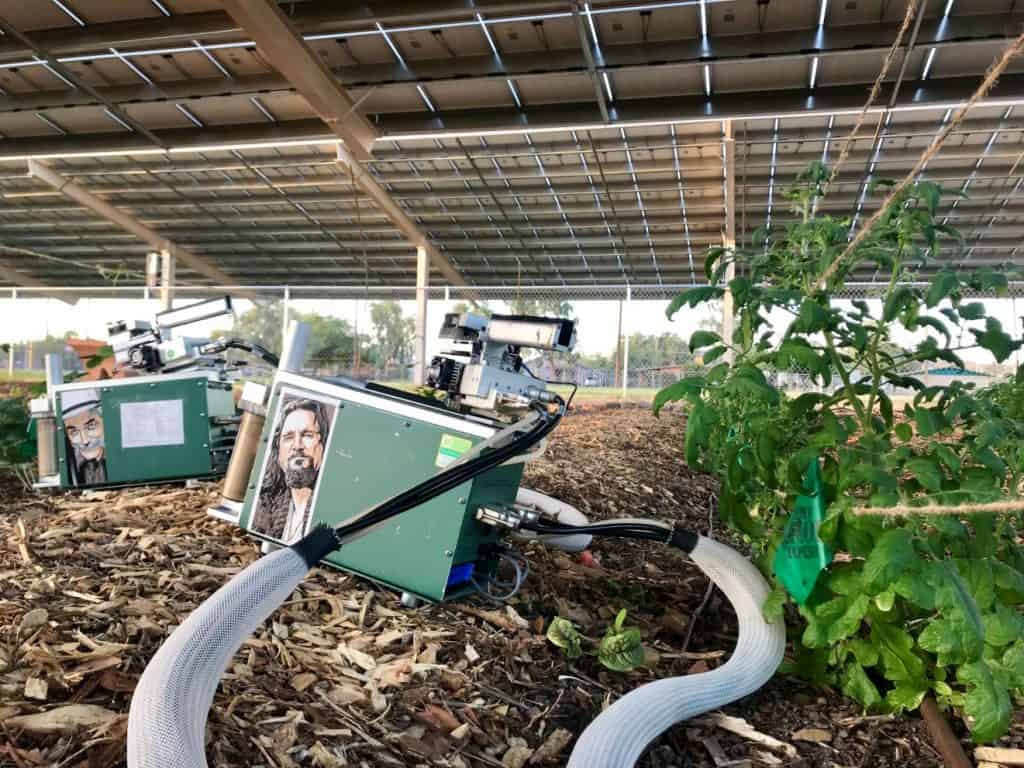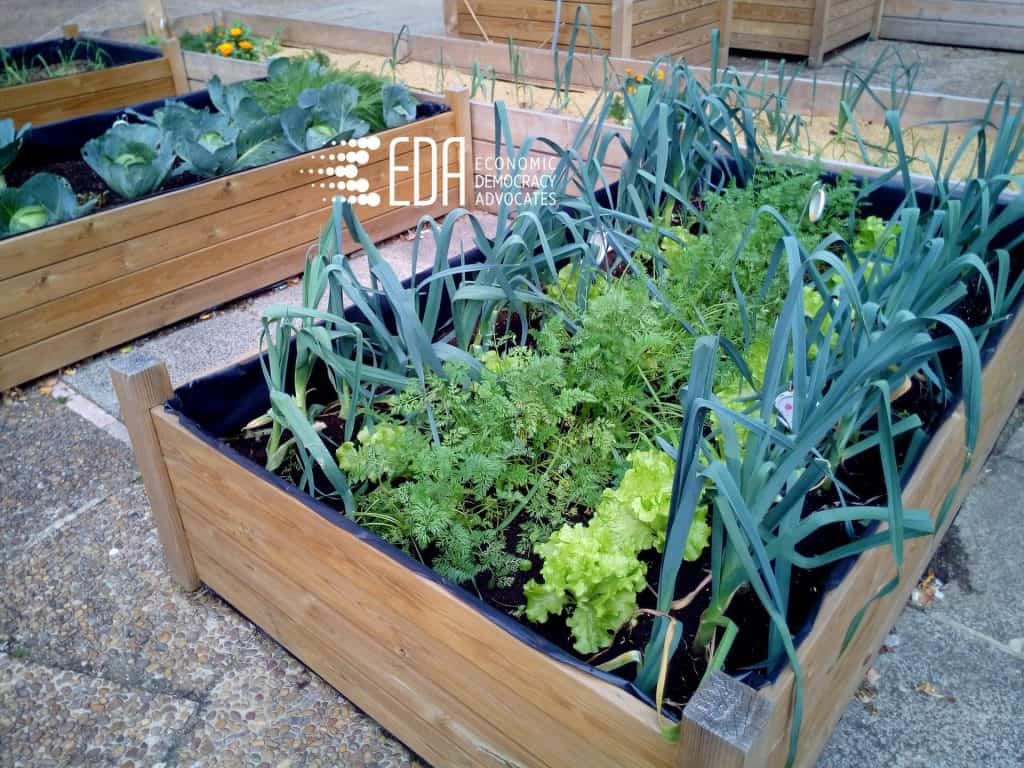The startup Square Roots is training the next generation of urban farmers in a Bed-Stuy parking lot.
One of the things that EDA believes in strongly is that sustainability in the future will rely on local efforts for food. That can serve as a challenge in urban areas. We recently released a post about the innovations in vertical farming and how this new way of growing food could make an impact on local distribution of freshly harvested vegetables.
This article, published in the Huffington Post describes an offshoot of that vertical farming technology that is brought down to the community level where farming is done in recycled shipping crates. The result is encouraging for the future of the locavore movement, bringing fresh vegetables to inner city neighborhoods – all year round.
As can be expected, there are some limitations that are being seen regarding energy costs. In the program described here, one of the pioneers is Kimbal Musk, brother of Elon Musk. We can imagine that in the near future the marriage of the solar roof tiles with these recycled shipping crates will be an experiment that will be worth watching.
The availability of locally grown fresh vegetables will make a huge difference in how we get fresh food. It changes the current dynamics of the way food is distributed, offering freshly harvested food to market in less than 24 hours. This experiment is one of a number that we’ll be seeing in the next several years. We’re looking forward to sharing more of this kind of innovation with you as we learn about it in the future.
[wpvideo XWizQVEr]BROOKLYN, New York ― Tobias Peggs is already cultivating leafy vegetables out of purple-lit shipping containers in the parking lot of an old Pfizer factory, just blocks from the projects where the rapper Jay-Z grew up.
What he needs to grow now is an industry.
Eight months ago, Peggs co-founded Square Roots ― a startup that coaches and equips would-be urban farmers with growing materials in repurposed 320-square-foot metal crates. He launched the venture with food and tech entrepreneur Kimbal Musk, the younger brother of Tesla and SpaceX CEO Elon Musk.
Now, 10 farmers are enrolled in Square Roots’ Brooklyn farming program, Peggs and Musk have launched a new delivery service for home-grown salad greens, and they’re deciding where to expand next.
“If we have a campus like this in every city, everyone can buy food from a local farmer,” said Peggs, 45, said as he showed The Huffington Post around his operation.
Located in the shadow of the Marcy Houses, a public housing complex in Brooklyn’s Bedford-Stuyvesant neighborhood, the former pharmaceutical plant that houses Square Roots now also provides office space for scientific research ventures and startups that ferment kombucha and kimchi, make high-end slushies and Madagascan chocolate, and even grow live oysters.
Peggs is Square Roots’ chief executive, and he has lofty plans to topple the industrial giants that dominate grocery aisles. “This is a very long-term play, to bring real food to everyone and unleash, basically, the next generation of leaders in food.”
“Ambitious,” he added with a laugh.

Alexander C. Kaufman/The Huffington Post
Ten shipping containers like this house Square Roots’ local farming initiative in Brooklyn, New York.
Square Roots was launched under the umbrella of The Kitchen LLC, Musk’s equally ambitious chain of farm-to-table eateries that he hopes will one day take over the food industry sector that TGI Friday’s and Applebee’s currently dominate.
Musk, 44, draws his inspiration from Chipotle Mexican Grill, where he serves as a board member. Chipotle leveraged its use of fresh, non-genetically modified ingredients to become a major rival of McDonald’s, despite charging higher prices. The Kitchen, which has three different restaurant concepts, operates primarily out of the American heartland, with nearly a dozen locations in Chicago, Memphis and throughout the state of Colorado. Another restaurant is slated to open in Indianapolis this year.
Musk and his colleagues are looking at all of those cities as the next possible site for a Square Roots campus.
“My heart is in Memphis, so if it were up to me, that’d be our next city,” Musk told HuffPost on Thursday, stressing that it’s ultimately up to Peggs. He wants to see Square Roots expand rapidly. “We are planning on doing this with thousands of kids a year within a few years.”
“If we have a campus like this in every city, everyone can buy food from a local farmer
-Tobias Peggs, chief executive of Square Roots
In Colorado, where The Kitchen is headquartered, it’s easy to get local produce, meat and alcohol. But that’s not true in a lot of major cities. That’s the niche Square Roots wants to fill. The company is the country’s first major indoor farming “accelerator” ― Silicon Valley parlance for firms that offer educational training, space and capital to bootstrapped entrepreneurs.
Enrollees complete an eight-week boot camp before setting up shop in one of Square Roots’ 10 shipping containers. They then have the next 10 months to grow vegetables and come up with novel ideas to sell them. Square Roots makes money by taking a cut of the revenue. If an idea takes off, Square Roots buys a stake in the company and introduces the farmer to other investors.
“I visualize opening Fortune magazine in 2050, and there’s a list of the top 100 food companies in America,” Peggs said. “No. 1 is Square Roots. And the other 99 have all been set up by folks who graduated from Square Roots.”
Indoor and vertical farming, essentially a techy subset of greenhouse agriculture, has recently attracted entrepreneurs competing to develop new hardware and the most energy- and water-efficient growing systems.
The benefits of growing indoors are numerous. Farmers don’t need pesticides or herbicides to ward off unwanted pests. They evade droughts, temperature shifts, whipping winds and flooding rains, all of which are becoming more destructive and erratic as greenhouse gases warm the planet and alter the climate. They are free from environmental contaminants ― a big plus in places like Japan, where, since the 2011 Fukushima Daiichi nuclear disaster, people fear radiation poisoning from food grown outdoors.
And on a baseline level, vegetables grown indoors under precise conditions can be bred to taste better. Peggs said one Square Roots farmer who is cultivating shiso, a red-leafed mint, used data on the climate in Hokkaido, Japan’s breadbasket northernmost island, to replicate conditions there. Instead of raising crops in one country and shipping them to another to be eaten, farmers could cut out the financial and environmental costs of transportation and grow even exotic produce in the dead of a New York winter.
“Let’s say the best basil you ever had was on vacation in Italy in 2006,” Peggs said. “You could look up the data on rainfall, temperatures and weather and grow basil in those exact same conditions.”
In September, Square Roots began working with the U.S. Department of Agriculture to rewrite criteria for government-backed loans, making them more accessible to indoor, urban growers.
The USDA postponed a meeting with Peggs scheduled for Thursday afternoon, hours after agriculture secretary nominee Sonny Perdue testified before a Senate hearing. The USDA did not respond to questions on Friday about the status of changes to the loan applications.
“We want these kids to know they’ll be getting a loan, and they’ll have to pay it back and have to build a business and make money for themselves all in the space of one year,” Musk said. “It’s a loan, not a grant. It’s not a handout; these are real businesses.”

Alexander C. Kaufman/The Huffington Post
Lettuce and arugula grow on long, vertical trays in the glow of purple LED lights.
For now, the nascent industry struggles with the challenge of hiring from a puddle-deep pool of trained talent. There’s just one serious graduate program in the country focused on indoor farming, at the University of Arizona, says Dickson Despommier, an emeritus professor of microbiology at Columbia University who hosts a podcast on urban agriculture.
“For every one that graduates, there are 10 jobs waiting for them,” Despommier told HuffPost by phone. “Demand is high, and production of qualified individuals is low.”
After two months of training, Maxwell Carmack took his engineering degree from Stony Brook University and his passion for building recording studios and applied them to indoor farming. Now, the 22-year-old from Long Island spends his mornings plucking lettuce and arugula from long, vertical grow trays before setting off across Brooklyn to deliver baggies stuffed with greens to the Williamsburg offices of Vice Media and the ad agency Huge’s headquarters in Dumbo.
“It’s my farm,” Carmack said after turning down the music blasting through his narrow container farm. “I have some volunteers that help me, but I make all the decisions on planting.”
It’s going to require a lot more than just people to shake an industrial farming business worth trillions of dollars globally. Critics say Square Roots’ model still doesn’t resolve key issues that limit indoor farming’s potential, like the steep electricity bills that drive-up prices of the greens. After all, sunlight is free for outdoor industrial farms.
Stan Cox, a lead scientist at the Salina, Kansas-based research nonprofit The Land Institute, is among the more vocal vertical farming skeptics. Among other things, he criticizes the high-energy costs, the high price point associated with vertically grown produce and the limited selection of crops — like leafy greens and tomatoes — that can effectively be grown this way. Cox believes the reliance on artificial light severely limits indoor farming’s output compared to that of a reasonably productive traditional farm.
“Calling a shipping container a ‘farm’ is like calling a hospital’s intensive care unit a ‘health club,’” Cox told HuffPost.

Alexander C. Kaufman/Huffington Post
Maxwell Carmack, 22, one of the inaugural enrollees in the Square Roots accelerator program.
And the lofty price of Square Roots’ greens — $7 for just one “nanobite” — reflects those high energy costs and means their appeal will be limited to a “boutique” market rather than a more inclusive one, Cox said. Each nanobite varies in weight, depending on that day’s yield, but is about the size of a bag of chips.
Square Roots, to its credit, is trying to find ways to make its greens available to low-income buyers. One enrollee, Paul Philpott, is working on a service that charges one set of customers extra to underwrite deliveries to customers who live in public housing in Hunts Point, a Bronx neighborhood where fresh produce is so scarce that the area qualifies as a food desert. Ironically, three of New York City’s biggest produce distributors are located in Hunts Point.
“He’s *right* at the beginning stages of the model, so is still figuring out specifics,” Peggs wrote of Philpott in a follow-up email. “However, it’s likely to be something like a $2 premium if you can afford it, which allows him to sell to a family living in a [New York City public housing] development for a $2 discount.”
Still, even skeptics see that a niche market of consumers willing to pay more for locally grown, vertically planted produce may have the potential to support operations like Square Roots.
Carl Zulauf, an agriculture professor at Ohio State University, said sustained interest from ambitious entrepreneurs like Musk and Peggs could be a sign that a viable model might not be that far off.
“Vertical farming can find a role if it can provide a high enough value to consumers relative to the price charged,” Zulauf said. “I think the window remains open for experimentation and market exploration.”
Article by Alexander C. Kaufman and Joseph Erbentraut
Originally published in Huffington Post


